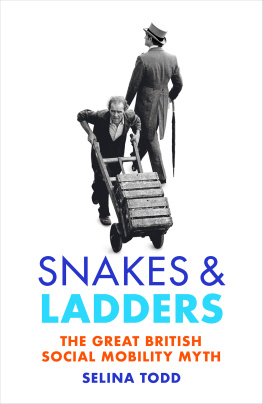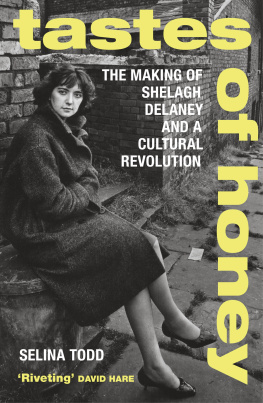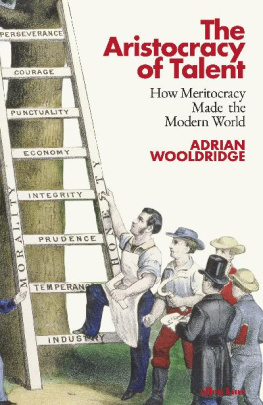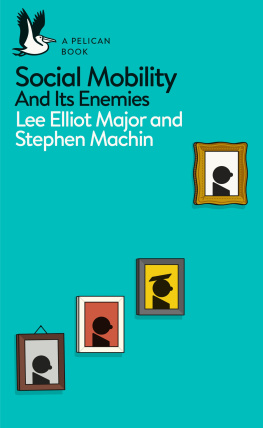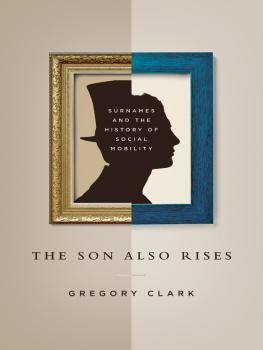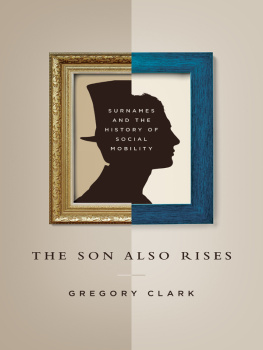

Selina Todd
SNAKES AND LADDERS
The Great British Social Mobility Myth

CONTENTS
- PART I :
THE PIONEERS 18801899 - PART II :
THE PRECARIOUS GENERATION 19001919 - PART III :
THE BREAKTHROUGH GENERATION 19201934 - PART IV :
THE GOLDEN GENERATION 19351955 - PART V :
THE MAGPIE GENERATION 19561971 - PART VI :
THATCHERS CHILDREN 19721985 THE MILLENNIALS 19861999
ABOUT THE AUTHOR
Selina Todd is Professor of Modern History at Oxford University. She grew up in Newcastle-upon-Tyne and was educated at Heaton Manor Comprehensive School and the Universities of Warwick and Sussex. She writes about class, inequality, working-class history, feminism and womens lives in modern Britain. Her book The People: The Rise and Fall of the Working Class 19102010 was a Sunday Times bestseller and was described by the Observer as A book we badly need. Based on the voices of working-class people themselves, it charted the history of ordinary workers, housewives, children and pensioners over the turbulent twentieth century.
BY THE SAME AUTHOR
Tastes of Honey: The Making of Shelagh Delaney and a Cultural Revolution
The People: The Rise and Fall of the Working Class 19102010
Young Women, Work and Family in England 19181950
For Sheila Forbes
LIST OF ILLUSTRATIONS
Plate Section I
Ruskin students in 1901 (courtesy of New Ruskin Archives)
A Workers Educational Association summer school, Durham, 1921 ( WEA North East)
Labour colleges banner, c. 1930 ( Peoples History Museum / National Labour History Archive)
Albert Mansbridge, founder of the WEA, 1913 ( WEA National Archives)
The Liverpool Suffrage Shop ( The Womens Library at LSE)
Ellen Wilkinson, c. 1900 ( General Photographic Agency / Stringer)
Clerks in a Sheffield steelworks, c. 1890 ( Universal History Archive / Contributor)
Conservative Party election poster, 192930 (reproduced by permission of the Conservative Party Archive Trust)
Domestic work is varied and pleasant poster, c. 1930 (courtesy of the Peoples History Museum)
Teacher and children at Box village school, Wiltshire, c. 1925 (courtesy of Stella Clarke and Joyce Smith)
The London Schoolmasters Association leaflet, campaigning against equal pay, 1919 ( Archive of the National Association of Schoolmasters, Modern Records Centre, University of Warwick)
Conservative Party election poster, 19318 (reproduced by permission of the Conservative Party Archive Trust)
Poster encouraging nurses to join a union ( TUC, Nurses and Health Service 193639, Modern Records Centre, University of Warwick)
Second World War evacuees from Bristol arrive in Devon, 1940 ( Imperial War Museum, D 2593)
Ernest Bevin, 1940 ( London Express / Stringer)
RAF flight-engineering cadets, 1944 ( Imperial War Museum, CH 12471)
Plate Section II
Labour Party election poster, 1945 ( Peoples History Museum / National Labour History Archive)
Aneurin Bevan, the founder of the NHS, is toured around the Park Hospital, Davyhulme, Lancashire, 1947 ( Richard Splash / Alamy Stock Photo)
)
Winchester College pupils, 1952 ( Popperfoto / Contributor)
Social scientists including Michael Young, Phyllis Willmott, Peter Willmott and Richard Titmuss, 1958 (Churchill Archives Centre, WLMT 1/13 Estate of Phyllis Willmott)
/ Nottingham Local Studies Library)
A Bradford Bangladeshi family, c. 1960 ( Bradford Museums and Galleries)
Harold Wilson meets the Beatles, 1964 ( Hulton Deutsch / Contributor)
Teacher and pupils at Clissold Comprehensive School, 1973 ( Bill Cross / Associated Newspapers / Shutterstock)
Ruth Hirst with fellow Ruskin College students, 1969 ( Ruth Todd)
Members of the Association of Scientific, Technical and Management Staff at the TUC International Womens Year Rally, London, 1975 ( TUC Library Collections at London Metropolitan University)
Schoolgirls in Coventry learning to use computers, 1987 ( Hulton Deutsch / Contributor)
Labour Party general election leaflet, 1987 ( the Peoples History Museum/National Labour History Archive)
Conservative Party election poster, 1979 (reproduced by permission of the Conservative Party Archive Trust)
The Patel family outside their corner shop in London, 2004 ( Richard Splash / Alamy Stock Photo)
Inequality in London in the 2000s ( Jack Taylor / Stringer)
Protestors who were part of the campaign that prevented Essex County Council from closing a third of the countys libraries ( Save Our Libraries Essex)
Every effort has been made by the publishers to trace the holders of copyright. Any inadvertent omissions of acknowledgement or permission can be rectified in future editions.
Experience isnt only whats happened to us. Its also what we wanted to happen.
R AYMOND W ILLIAMS , B ORDER C OUNTRY (1960)
INTRODUCTION
That our hard work, talent and ambition will make us rich, powerful and happy is an alluring story. Its one that generations of politicians, employers and teachers have encouraged us to believe. Without that promise, the inequality inherent in capitalist societies where a few people at the top of the ladder hold wealth and power, while most people have very little looks unfair. But if the rung we are on is determined by our efforts, then those at the top deserve reward. Everyone benefits, because the chance to climb the ladder encourages ambition, competition to do so makes people work harder, and this increases productivity. Even the idle and feckless on the lowest rungs gain from the ideas and innovations that the talented and hard-working produce, and from the economic growth that their ventures create.
But this is a myth. Those men and women born between 1880 and the end of the nineteenth century were the first generation of whom a majority moved up or down the ladder. Thats been true of every generation since. Yet despite this, over the past 140 years, birth and wealth have exercised a far greater influence on a persons social position than talent, effort or ambition.
This book explains why. It tells the story of those who lived through these decades, revealing who created and reformed the social ladder; how and why people sought to change their lives and, sometimes, to transform the society they lived in; and the experience of those who climbed or slid down the ladder.
Social mobility measures how far a person travels from their parents social class (although in this book, I also explore peoples mobility across their own lives). Measurements of social mobility, whether used by politicians or social scientists, invite us to see society as a ladder, with each rung defined by social and economic status. Most researchers of social mobility use occupation as the basis for defining a persons social class (though income and sometimes taste also play a part). Their ladder usually comprises five or seven rungs, from unskilled work at the bottom to senior professionals and the owners of big businesses at the top.
Next page
